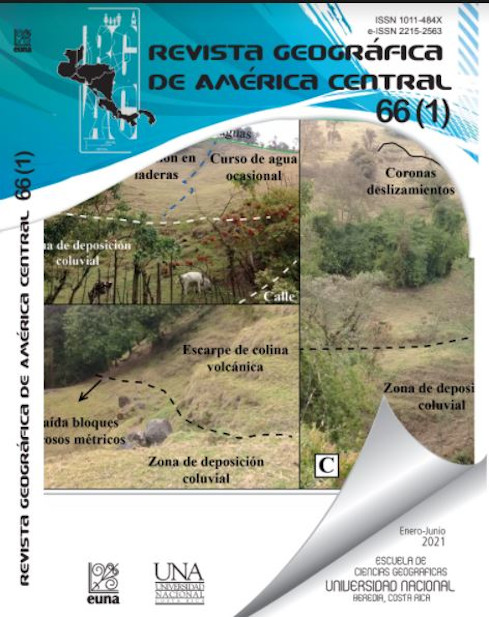Ecotourism potential in Protected Natural Areas. Case: Tirimbina Biological Reserve (RBT), Sarapiquí, Province of Heredia, Costa Rica.
DOI:
https://doi.org/10.15359/rgac.66-1.11Keywords:
Tourism potential, Ecotourism, Tirimbina Biological Reserve (RBT), Environmental educationAbstract
This article describes the main tourism potentials of the Reserva Biológica Tirimbina (RBT) (translated as Tirimbina Biological Reserve). The ecotourism potential level is determined based on an analysis of important variables and from the descriptive characteristics of RBT. Currently, RBT sustains multiple nature and educational research programs, as well as a striking offering of tours that promote tourist interaction and learning in nature-based settings. According to the proposed weighting methodology, where six relevant variables were identified and each variable evaluated based on key attributes assigned individual corresponding weight values, RBT is characterized as possessing a high ecotourism potential wherein ecological trail hiking activities predominates over all evaluated attributes. The reserve is a source of employment for the local population, promotes environmental protection and education, and greatly boosts tourism with the potential to link to other more consolidated touristic value chains.
References
Acosta Villegas, M. (2008). Evaluación del potencial ecoturístico de un sector de la región Sierra-Costa de Michoacán. (Tesis inédita de Maestra). Universidad Nacional Autónoma de México, Morelia, México. 109 pp.
Coppin. L (s.f.). Ecoturismo y América Latina: una aproximación al tema. Tourism as Economic Activity: OTS in Costa Rica, FPEI Working Paper N°33. 8 pp.
Durán. F. (s.f.). Lugar de publicación: ECOBIOSIS. Disponible en: http://ecobiosis.museocostarica.go.cr/ecosistemas/index.aspx
Fennell, D. (2008). Ecotourism. 3ra ed. London y New York: Ed. Routledge and Taylor & Francis.
Fierro Bandala, E.; Lagunas Vázques, M. y Ortega Rubio, A.; (2013). El ecoturismo y el turismo de naturaleza como alternativa de desarrollo rural en la REBIOSLA. En: Lagunas Vázques M.; Beltrán Morales, L. y Ortega Rubio, A; (2013). Diagnóstico y análisis de los aspectos sociales y económicos en la reserva de la biosfera Sierra La Laguna, Baja California Sur, México. Centro de Investigaciones Biológicas del Noroeste S.C. La Paz, B.C.S., México. 340 pp.
Flores, Á. (2011). “Zonificación funcional ecoturística de la zona costera de Michoacán, México a escala 1:250 000”. Revista Geográfica De América Central. 2 (47E): 1-15 pp.
Guzmán Chávez, M. y Juárez Bolaños, D. (2013). En busca del ecoturismo. Casos y experiencias del turismo sustentable en México, Costa Rica, Brasil y Australia. México: Ediciones EÓN Sociales.
Hasse, G. (1986). Theorethical and methodological foundations of landscape ecology, in: Landscape Ecology. Abstract of Lecture. International Training Course. Institute of Geography and Geoecology, GDR Academy of Science, Leipzig. 4-7 pp.
Herrera, W. (1985). “Clima de Costa Rica. Vegetación y clima de Costa Rica”. (Vol. 2). EUNED. San José, Costa Rica.
Holdridge, L. (1967). “Life Zone Ecology”. Tropical Science Center. San José, Costa Rica. 149 pp.
Honey, M. (2008). Ecotourism and sustainable development: Who owns paradise?. 2a ed. Washington: Ed. Island Press.
Huerta, M. y Sánchez, A. (2011). “Evaluación del Potencial Ecoturístico en Áreas Naturales Protegidas del Municipio de Santa María Huatulcu, México”. Cuadernos de Turismo. 541-560 pp.
Instituto Nacional de Estadística y Censos [INEC]. (2020). Empleo y Pobreza por línea de ingreso. Lugar de publicación: Página web del INEC. Disponible en: https://www.inec.cr/empleo y https://www.inec.cr/pobreza-y-desigualdad/pobreza-por-linea-de-ingreso
García, M. (2019). Comunicación personal y correo electrónico, 16 de julio 2019 (entrevista).
Morera, C. (2001). “Ecoturismo y Desarrollo local en la Península de Osa, Costa Rica”. Revista Geográfica de América Central. 1 (39): 41-74 pp.
Municipalidad de Sarapiquí. (2012). Información Poblacional. Obtenido de Municipalidad de Sarapiquí. Lugar de publicación: Página web de la Municipalidad de Sarapiquí. Disponible en: https://sarapiqui.go.cr/nuestra-municipalidad/datos-generales/136-informacion-poblacional
Programa de las Naciones Unidas para el Desarrollo [PNUD]. (2011). Atlas del desarrollo humano cantonal de Costa Rica 2011. Lugar de publicación: Página web. Disponible en: https://www.undp.org/content/dam/costa_rica/docs/undp_cr_atlas_cantonal.pdf
Quesada, A. G. (2019). Conozca el osito más pequeño del planeta habitante de nuestros bosques. Lugar de publicación: El Norte Hoy. Disponible en: https://elnortehoy.wordpress.com/2019/12/31/conozca-el-osito-mas-pequeno-del-planeta-habitante-de-nuestros-bosques/
Reserva Biológica Tirimbina. (s.f.). Tours. Lugar de publicación: Página web de Tirimbina. Disponible en: https://www.tirimbina.org/tours/
Sarapiquí Sostenible. (2018). Generalidades del destino. Lugar de publicación: Sarapiquí Sostenible. Disponible en: https://sarapiquisostenible.com/generalidades-del-destino/.
Thornthwaite, C. (1948). “An approach toward a Rational Classification of Climate”. Geographical Re-view. 38(1): 55-94 pp.
Vega, A. (2014). Caracterización Territorio Sarapiquí. Lugar de publicación: INDER. Disponible en: https://www.inder.go.cr/territorios_inder/region_huetar_norte/caracterizaciones/Caracterizacion%20Territorio%20Sarapiqui.pdf
Weaver, D. y Lawton, L. (2007). “The state of contemporary ecotourism research”. Tourism Management. 28 (2007): 1168-1179 pp.
Downloads
Published
How to Cite
Issue
Section
License
Proposed policy for journals offering Open Access
Authors publishing their works in the Journal acknowledge and agree to the following terms:
a) Authors retain the copyrights to their works and guarantee the Journal the right to be the first to publish their works, under the Creative Commons License Attribution-NonCommercial-ShareAlike 4.0 International, CC BY-NC-SA 4.0 International (https://creativecommons.org/licenses/by-nc-sa/4.0/deed.es), which allows others to share works upon complying with the acknowledgment of authorship and mention of the Journal as the original publisher of the work.
b) Authors are permitted to separately establish additional agreements for the non-exclusive distribution of the official edition of the work published in the Journal (for example, authors may desire to place the work in an institutional repository or incorporate it into a book that is to published elsewhere) so long they acknowledgment to recognize the Journal as the original publisher. The aforementioned additional agreements must respect the terms of the non-profit character and sharing philosophy of the original license (CC BY-NC-SA 4.0 International, https://creativecommons.org/licenses/by-nc-sa/4.0/deed.es).
c) Authors are encouraged to archive the post-print or editor/PDF version in Open Access repositories.






 REVGEO is licensed under https://creativecommons.org/licenses/by-nc-sa/4.0/deed.es
REVGEO is licensed under https://creativecommons.org/licenses/by-nc-sa/4.0/deed.es
.svg_4.png)

_(1).png)
_(1)_(1)_(1)_1.png)
(2)(1)(1)(1).png)
